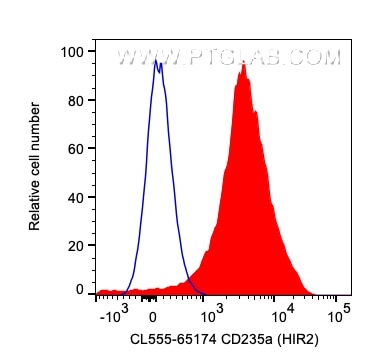CD235a Monoklonaler Antikörper
CD235a Monoklonal Antikörper für FC
Wirt / Isotyp
Maus / IgG2b, kappa
Getestete Reaktivität
human
Anwendung
FC
Konjugation
CoraLite® Plus 555 Fluorescent Dye
CloneNo.
HIR2
Kat-Nr. : CL555-65174
Synonyme
Galerie der Validierungsdaten
Geprüfte Anwendungen
| Erfolgreiche Detektion in FC | humane Erythrozyten |
Empfohlene Verdünnung
| Anwendung | Verdünnung |
|---|---|
| This reagent has been pre-titrated and tested for flow cytometric analysis. The suggested use of this reagent is 5 µl per 10^6 cells in a 100 µl suspension or 5 µl per 100 µl of whole blood. | |
| Sample-dependent, check data in validation data gallery | |
Produktinformation
CL555-65174 bindet in FC CD235a und zeigt Reaktivität mit human
| Getestete Reaktivität | human |
| Wirt / Isotyp | Maus / IgG2b, kappa |
| Klonalität | Monoklonal |
| Typ | Antikörper |
| Immunogen | Synthetisches Peptid (Human, N-Terminus) |
| Vollständiger Name | glycophorin A (MNS blood group) |
| Berechnetes Molekulargewicht | 150 aa, 16 kDa |
| GenBank-Zugangsnummer | BC005319 |
| Gene symbol | GYPA |
| Gene ID (NCBI) | 2993 |
| Konjugation | CoraLite® Plus 555 Fluorescent Dye |
| Excitation/Emission maxima wavelengths | 554 nm / 570 nm |
| Form | Liquid |
| Reinigungsmethode | Affinitätsreinigung |
| Lagerungspuffer | PBS with 0.09% sodium azide and 0.5% BSA. |
| Lagerungsbedingungen | Store at 2-8°C. Avoid exposure to light. Stable for one year after shipment. |
Hintergrundinformationen
Glycophorin A (GYPA) is the major transmembrane sialoglycoprotein in erythrocytes. It is a dimeric type I transmembrane protein carrying 15 closely clustered O-linked tetrasaccharides capped with sialic acid/N-acetylneuraminic acid (Neu5Ac). This 36 kDa protein represents the major sialoglycoprotein of the red blood cell membrane displaying about one million copies per cell. (PMID: 9490702)
Protokolle
| Produktspezifische Protokolle | |
|---|---|
| FC protocol for CL Plus 555 CD235a antibody CL555-65174 | Protokoll herunterladen |
| Standard-Protokolle | |
|---|---|
| Klicken Sie hier, um unsere Standardprotokolle anzuzeigen |


